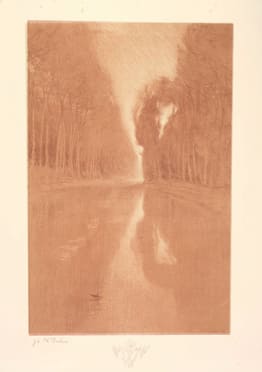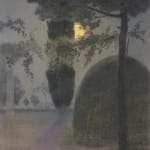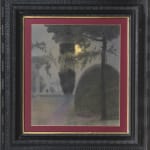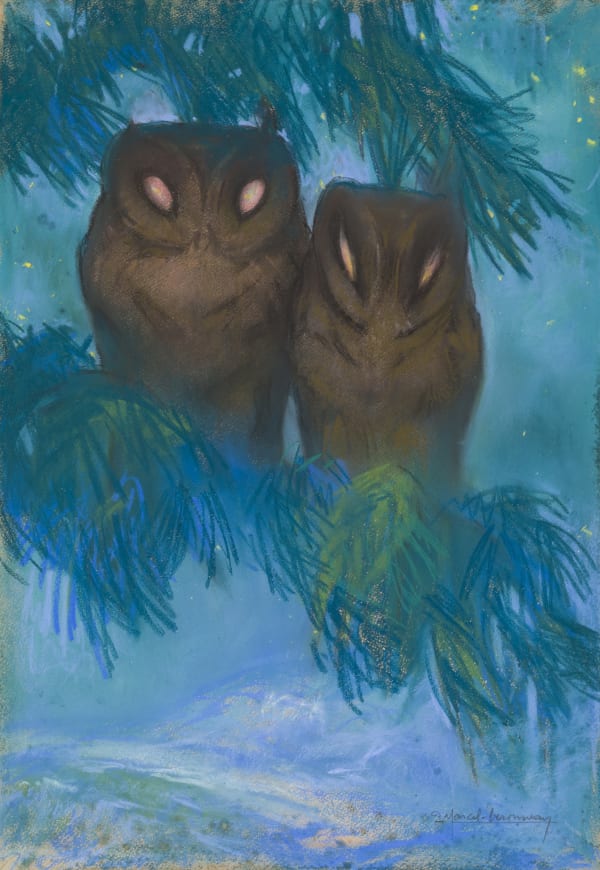

GIOVANNI GUERRINI
SOLD
An eclectic temperament, naturally inclined to experimentation, Giovanni Guerrini engaged in many kinds of artistic activities. He received a polytechnic education which, over time, he would be able to deploy in various fields of expression: in fact, he would end up being a painter, lithographer, cartoonist, designer of objects and furniture, a bodybuilder, and architect. A volcanic and versatile activity whose origins lay in his education at the School of Design of Faenza where he had enrolled in 1902. There, together with his friends Domenico Rambelli, Ercole Drei and Giuseppe Ugonia, he was a member of the “Baccarinian Cenacle” – a group inspired by Art Nouveau, moving between purism and English Pre-Raphaelite and Central European symbolism. He continued his studies at the Academy of Fine Arts in Florence, and then began to exhibit his lithographs locally and nationally. In 1912, he took part in the Venice Biennale where he would also be present in 1914, and then uninterruptedly from 1920 to 1936.
He taught architecture and decorative painting at the Academy of Fine Arts in Ravenna. In 1922, an arson attack destroyed the wall decorations he had painted in the Palazzo delle Cooperative of Ravenna. Later on, his style became more realistic. Together with the architects Ernesto Bruno Lapadula and Mario Romano, he designed the Palazzo della Civiltà Italiana at the EUR in Rome. He founded the State Institute of Mosaic Art in Ravenna and directed it from 1961 onwards.
His works have become part of such prestigious collections as the Municipal Galleries of Rome and Milan, the museums of Cremona, Tokyo, and Lima.
In his painting echoes of the time he lived in can be found, but interpreted in a personal way through a language of refined formal sobriety.
In parallel to his artistic activities featuring essential lines and strong Symbolist references, Giovanni Guerrini also dedicated much research and experimentation to the landscape, seen as a representation of states of mind. Far removed from anything that sought to be an exercise of references and associations, it is evident that some of his landscapes, such as the drawing being presented here, were particularly affected by the work of the French artist Charles-Marie Dulac, which he had most likely seen in Ravenna[1] (FIG. 1).

FIG. 1 - Charles-Marie Dulac, Les ètoils du matin, 1893, litografie, tavola II from the serie “Suite de paysages”.
These were works by Guerrini that preferred the intimate hues of backlighting, dawns and dusks, and Nocturne - Moonlight is a perfect example of them. It represents one of the very few incursions of the artist into the divisionist technique. In it are combined the two main currents which in those years dominated the graphic arts: the Symbolist thrust which charged the figure with feeling, making it a conveyor of allegories, and the typically Italian attention to drawing.
This highly particular and poetic subject was very dear to Guerrini; an isolated location, a night which through plays of light and shadowy niches conveys a sense of mystery which so enthralled the artist and continues to beguile the spectator.
Join the mailing list
Subscribe to our newsletter to receive all the news about exhibitions, fairs and new acquisitions!




